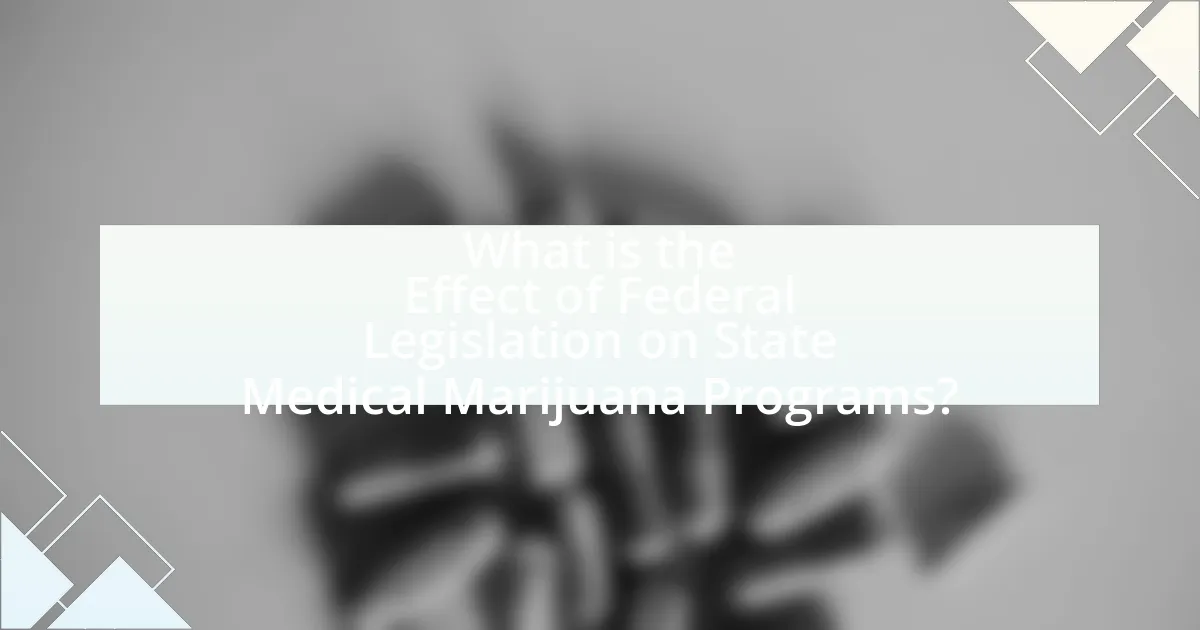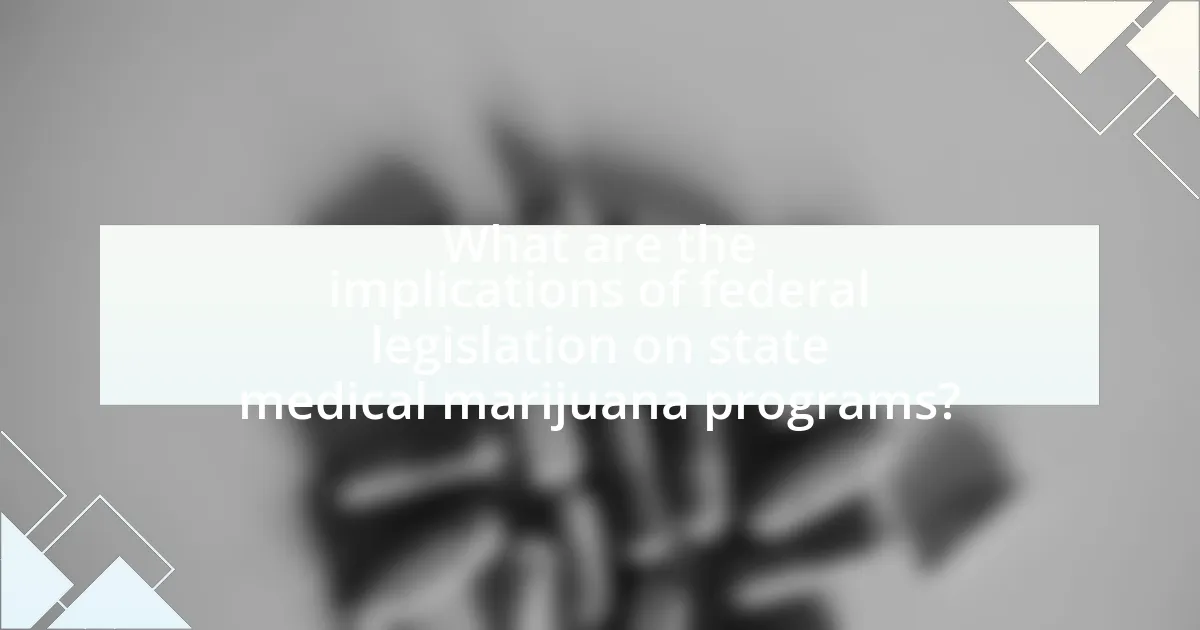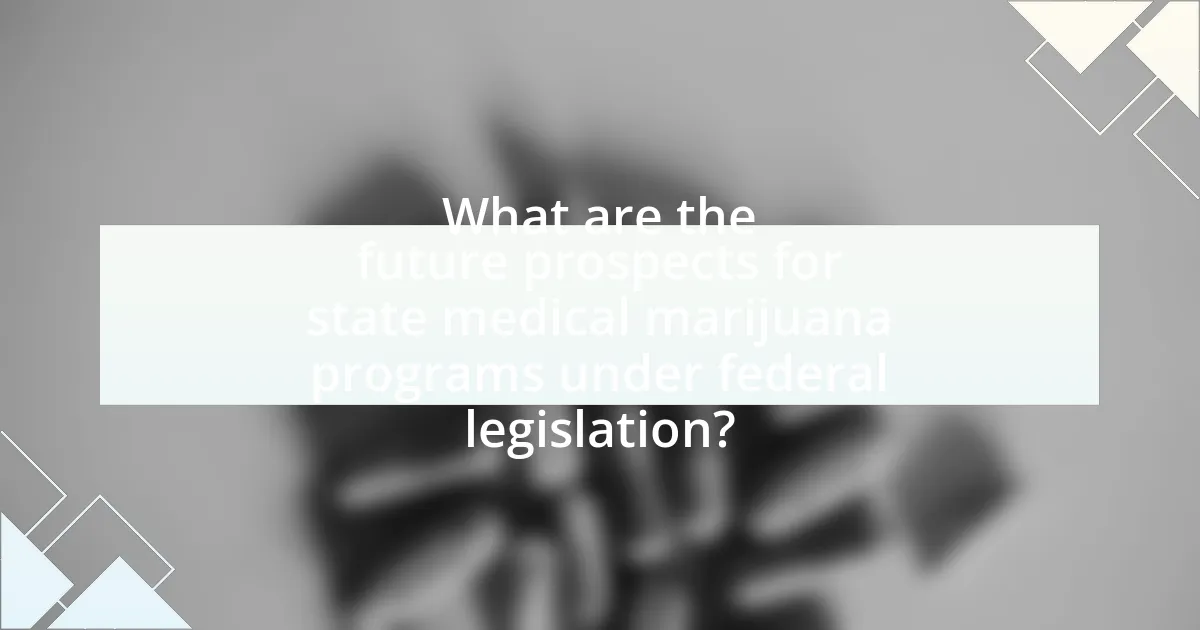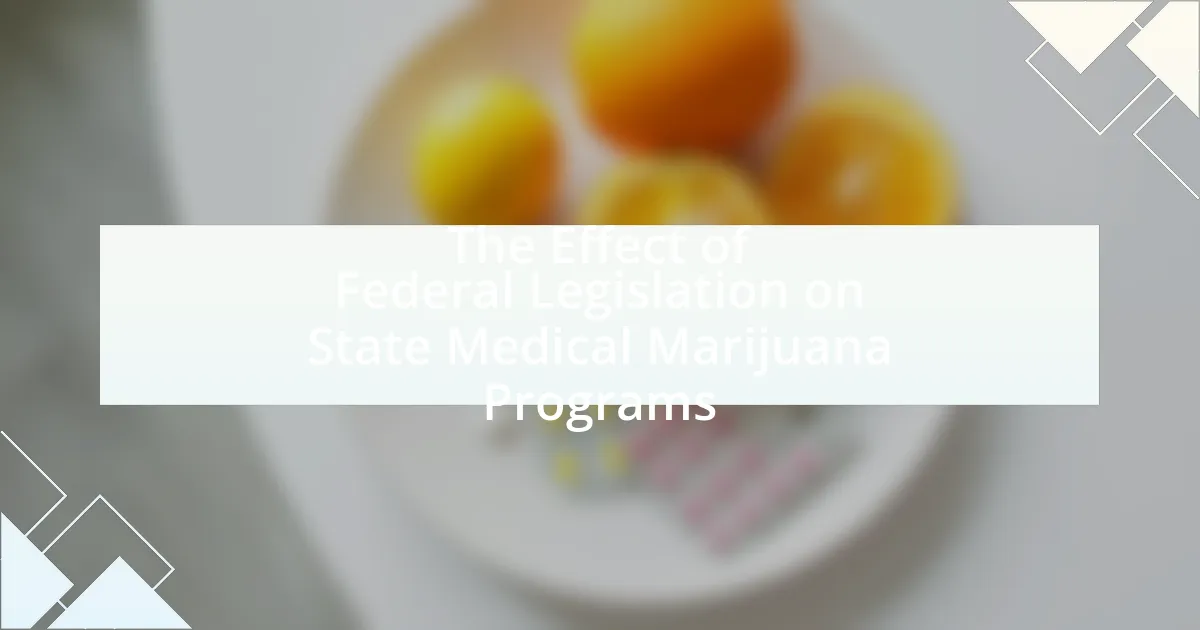The article examines the significant impact of federal legislation on state medical marijuana programs, highlighting the legal conflicts arising from the classification of marijuana as a Schedule I substance under the Controlled Substances Act. It discusses how federal laws, such as the Rohrabacher-Farr Amendment, influence state regulations, enforcement policies, and patient access to medical marijuana. The article also addresses the challenges states face due to federal prohibition, including financial limitations and regulatory complexities, while exploring potential future reforms and strategies for states to advocate for their medical marijuana initiatives. Overall, it provides a comprehensive overview of the intricate relationship between federal and state laws regarding medical marijuana.

What is the Effect of Federal Legislation on State Medical Marijuana Programs?
Federal legislation significantly impacts state medical marijuana programs by creating a legal conflict between state and federal laws. While many states have legalized medical marijuana, it remains classified as a Schedule I substance under the Controlled Substances Act, which prohibits its use and distribution. This federal classification leads to challenges for state programs, including limited access to banking services for cannabis businesses and potential federal enforcement actions against state-licensed operations. For instance, the Cole Memo, issued in 2013, provided some guidance for federal enforcement priorities but was rescinded in 2018, increasing uncertainty for states. Consequently, states must navigate the complexities of operating medical marijuana programs in a legal gray area, balancing state laws with the risk of federal intervention.
How does federal legislation influence state medical marijuana laws?
Federal legislation significantly influences state medical marijuana laws by establishing a legal framework that can either restrict or enable state-level policies. The Controlled Substances Act classifies marijuana as a Schedule I substance, which creates a conflict for states that have legalized medical marijuana, as federal law supersedes state law under the Supremacy Clause of the U.S. Constitution. This federal classification can lead to federal enforcement actions against state-licensed medical marijuana operations, creating uncertainty for patients and providers. Additionally, federal legislation, such as the Rohrabacher-Farr amendment, has provided some protections by prohibiting the use of federal funds to interfere with state medical marijuana laws, thereby allowing states to implement their programs with reduced federal oversight.
What are the key federal laws affecting medical marijuana?
The key federal laws affecting medical marijuana include the Controlled Substances Act (CSA) and the Rohrabacher-Farr Amendment. The CSA classifies marijuana as a Schedule I substance, which prohibits its use and distribution at the federal level. This classification creates significant legal barriers for medical marijuana programs, as it undermines state laws that permit medical use. The Rohrabacher-Farr Amendment, enacted in 2014, restricts the Department of Justice from using federal funds to interfere with state medical marijuana laws, providing some protection for states that have legalized medical marijuana. These laws illustrate the complex relationship between federal and state regulations regarding medical marijuana.
How do federal enforcement policies impact state programs?
Federal enforcement policies significantly impact state medical marijuana programs by creating a legal and regulatory framework that states must navigate. For instance, the federal classification of marijuana as a Schedule I substance under the Controlled Substances Act complicates state efforts to implement and regulate medical marijuana programs. This classification leads to uncertainty for state officials and participants, as federal authorities can enforce federal laws despite state legalization efforts.
Evidence of this impact is seen in the fluctuating enforcement priorities of federal agencies, such as the Department of Justice, which have historically shifted between strict enforcement and more lenient approaches, influencing state program operations and investments. For example, the Cole Memorandum issued in 2013 provided guidance that allowed states to regulate their medical marijuana programs with less federal interference, but its rescission in 2018 created renewed concerns among state officials and stakeholders about potential federal crackdowns.
Why is the relationship between federal and state laws significant?
The relationship between federal and state laws is significant because it determines the legal framework within which states can operate, especially regarding issues like medical marijuana. Federal law, which classifies marijuana as a Schedule I substance under the Controlled Substances Act, creates a conflict with state laws that have legalized medical marijuana, leading to legal ambiguities and challenges for state programs. This tension affects how states implement their medical marijuana laws, as they must navigate the risk of federal enforcement actions against their programs, despite state-level legalization efforts.
What challenges do states face due to federal prohibition?
States face significant challenges due to federal prohibition of marijuana, primarily in the form of legal conflicts and financial limitations. The conflict arises because while states may legalize marijuana for medical or recreational use, federal law classifies it as a Schedule I substance, creating a legal gray area that complicates enforcement and regulation. This discrepancy leads to difficulties in banking, as many financial institutions are hesitant to serve marijuana-related businesses due to the risk of federal prosecution, limiting access to essential financial services. Additionally, states may struggle with the allocation of resources for law enforcement and public health initiatives, as federal funding often excludes marijuana-related programs. These challenges hinder the effective implementation of state medical marijuana programs and create uncertainty for both consumers and businesses operating within those states.
How do state programs adapt to federal changes?
State programs adapt to federal changes by modifying their regulations and policies to align with new federal guidelines while addressing local needs. For instance, when the federal government alters its stance on medical marijuana, states may revise their licensing processes, adjust possession limits, or implement new compliance measures to ensure that state laws remain in harmony with federal expectations. This adaptability is often driven by the need to maintain funding, avoid legal conflicts, and ensure public safety, as evidenced by states like California and Colorado, which have updated their medical marijuana frameworks in response to shifting federal enforcement priorities.

What are the implications of federal legislation on state medical marijuana programs?
Federal legislation significantly impacts state medical marijuana programs by creating legal uncertainties and potential conflicts. The Controlled Substances Act classifies marijuana as a Schedule I substance, which contradicts state laws that permit medical use. This federal classification can lead to challenges for state programs, including the risk of federal enforcement actions against dispensaries and patients. Additionally, federal restrictions limit access to banking services for cannabis businesses, complicating financial operations. As of October 2023, despite some states legalizing medical marijuana, the federal stance continues to create a complex legal landscape that affects the implementation and sustainability of state programs.
How does federal legislation affect patient access to medical marijuana?
Federal legislation significantly restricts patient access to medical marijuana by classifying it as a Schedule I controlled substance under the Controlled Substances Act. This classification implies that marijuana has a high potential for abuse and no accepted medical use, which creates barriers for patients seeking legal access. Consequently, despite state laws permitting medical marijuana use, federal law can lead to legal risks for patients, healthcare providers, and dispensaries, limiting the availability of medical marijuana in states where it is legalized. For instance, federal enforcement actions have historically targeted state-licensed dispensaries, creating an environment of uncertainty that affects patient access.
What barriers do patients encounter in states with medical marijuana programs?
Patients encounter several barriers in states with medical marijuana programs, including high costs, limited access to dispensaries, and complex regulatory requirements. High costs can deter patients from obtaining medical marijuana, as many insurance plans do not cover these expenses, leading to significant out-of-pocket expenses. Limited access to dispensaries is another challenge, as some states have a restricted number of licensed facilities, making it difficult for patients to obtain their medication. Additionally, complex regulatory requirements, such as obtaining a physician’s recommendation and navigating state-specific application processes, can create obstacles for patients seeking to participate in these programs. These barriers collectively hinder patient access to medical marijuana, impacting their ability to manage health conditions effectively.
How do federal policies shape the availability of medical marijuana products?
Federal policies significantly influence the availability of medical marijuana products by establishing legal frameworks that govern production, distribution, and access. The classification of marijuana as a Schedule I substance under the Controlled Substances Act restricts research and limits the ability of states to implement comprehensive medical marijuana programs. Consequently, states face challenges in regulating the market, leading to variations in product availability. For instance, states with more lenient laws may have a wider range of products, while those adhering strictly to federal guidelines may see limited options. Additionally, federal enforcement actions can deter businesses from entering the market, further impacting product availability.
What economic impacts arise from federal legislation on state programs?
Federal legislation significantly impacts state programs by influencing funding, regulatory frameworks, and economic incentives. For instance, when federal laws restrict or support certain activities, such as medical marijuana use, states may experience shifts in tax revenue, healthcare costs, and law enforcement expenditures. A study by the National Bureau of Economic Research found that states with legalized medical marijuana saw a reduction in prescription drug costs, indicating a direct economic benefit from state-level programs influenced by federal legislation. Additionally, federal funding can either enhance or limit state program capabilities, affecting overall economic stability and growth within those states.
How does federal legislation influence state tax revenues from medical marijuana?
Federal legislation significantly influences state tax revenues from medical marijuana by creating a complex legal environment that affects state taxation policies. The classification of marijuana as a Schedule I substance under the Controlled Substances Act restricts banks from providing services to cannabis businesses, leading to cash-only operations that complicate tax collection. According to a 2020 report by the Congressional Research Service, states with legalized medical marijuana face challenges in enforcing tax compliance and collecting revenue due to these federal restrictions. Additionally, federal tax code Section 280E prohibits cannabis businesses from deducting ordinary business expenses, resulting in higher effective tax rates and limiting the financial benefits that states could otherwise derive from taxation. This legal framework ultimately shapes the amount of tax revenue states can generate from medical marijuana programs.
What are the economic consequences for businesses operating in the medical marijuana sector?
Businesses operating in the medical marijuana sector face significant economic consequences, including high taxation, limited access to banking services, and fluctuating market demand. The Internal Revenue Code Section 280E prohibits businesses from deducting ordinary business expenses related to the sale of marijuana, leading to effective tax rates that can exceed 70%. Additionally, many banks are hesitant to provide services to these businesses due to federal illegality, forcing them to operate on a cash-only basis, which increases security risks and operational costs. Market demand can also be unstable, influenced by changing state regulations and public perception, which can affect revenue stability. These factors collectively create a challenging economic environment for medical marijuana businesses.

What are the future prospects for state medical marijuana programs under federal legislation?
The future prospects for state medical marijuana programs under federal legislation are likely to improve as more states legalize medical marijuana and federal policies evolve. Recent legislative efforts, such as the introduction of the Cannabis Administration and Opportunity Act, aim to decriminalize cannabis at the federal level, which could provide states with greater autonomy in regulating their medical marijuana programs. Additionally, public support for legalization has reached approximately 68% according to a Gallup poll conducted in 2021, indicating a shift in societal attitudes that may influence future federal decisions. As federal legislation continues to progress, state programs may benefit from increased funding, research opportunities, and a more stable regulatory environment.
How might changes in federal legislation affect state medical marijuana programs?
Changes in federal legislation can significantly impact state medical marijuana programs by altering the legal status and regulatory framework surrounding cannabis. For instance, if the federal government were to decriminalize or legalize marijuana, states might experience increased funding and support for their medical programs, as seen in states like Colorado, which benefited from federal grants after legalization. Conversely, stricter federal enforcement could lead to state programs facing legal challenges or funding cuts, as evidenced by the rescission of the Cole Memo in 2018, which allowed for increased federal crackdowns on state-legal cannabis operations. Thus, the interplay between federal and state laws directly influences the viability and operation of state medical marijuana initiatives.
What potential reforms are being discussed at the federal level?
Potential reforms being discussed at the federal level include the legalization of cannabis, the rescheduling of marijuana under the Controlled Substances Act, and the implementation of a regulatory framework for its use. These reforms aim to address inconsistencies between state and federal laws regarding medical marijuana, which currently create legal ambiguities for patients and providers. For instance, the Cannabis Administration and Opportunity Act proposes to remove cannabis from the list of controlled substances, thereby allowing states to regulate its use without federal interference. Additionally, the SAFE Banking Act seeks to provide financial institutions with the ability to work with cannabis-related businesses, enhancing economic opportunities in states where medical marijuana is legal.
How could shifts in public opinion influence federal policies?
Shifts in public opinion can significantly influence federal policies by prompting lawmakers to align legislation with the evolving views of their constituents. For instance, as public support for medical marijuana has increased, evidenced by a Gallup poll in 2021 showing 68% of Americans favoring legalization, federal policymakers have begun to reconsider restrictive laws surrounding cannabis. This shift in public sentiment has led to legislative proposals aimed at decriminalizing marijuana at the federal level, reflecting the need for policies that resonate with the majority opinion. Consequently, as public attitudes continue to evolve, federal policies are likely to adapt in response to maintain political support and address the demands of the electorate.
What best practices can states adopt in response to federal legislation?
States can adopt best practices such as aligning state laws with federal guidelines, implementing robust regulatory frameworks, and fostering collaboration with federal agencies. By aligning state laws with federal guidelines, states can reduce legal conflicts and ensure compliance, as seen in states that have adjusted their medical marijuana regulations to reflect federal standards. Implementing robust regulatory frameworks helps ensure safety and quality in medical marijuana programs, which can be evidenced by states like Colorado, where comprehensive regulations have led to successful program outcomes. Additionally, fostering collaboration with federal agencies can facilitate better communication and resource sharing, as demonstrated by states that have engaged in dialogue with the Drug Enforcement Administration to clarify enforcement priorities.
How can states ensure compliance while maximizing patient access?
States can ensure compliance while maximizing patient access by implementing robust regulatory frameworks that balance oversight with accessibility. These frameworks can include clear guidelines for medical marijuana distribution, patient eligibility, and caregiver roles, which help maintain compliance with federal laws while facilitating patient access. For instance, states like California have established comprehensive licensing systems for dispensaries that ensure product safety and quality, while also allowing for a wide range of patients to obtain necessary medications. Additionally, states can utilize technology, such as online patient registration systems, to streamline access and maintain accurate records, thereby enhancing compliance with both state and federal regulations. This dual approach of regulatory clarity and technological integration has been shown to improve patient access without compromising legal adherence.
What strategies can states implement to advocate for their medical marijuana programs?
States can implement several strategies to advocate for their medical marijuana programs, including public education campaigns, legislative lobbying, and partnerships with healthcare providers. Public education campaigns can inform citizens about the benefits and legality of medical marijuana, thereby increasing support and participation in these programs. Legislative lobbying involves engaging with lawmakers to promote favorable policies and funding for medical marijuana initiatives, which can enhance program sustainability. Additionally, forming partnerships with healthcare providers can facilitate better patient access and professional endorsement, reinforcing the legitimacy of medical marijuana as a treatment option. These strategies are supported by evidence showing that states with robust advocacy efforts tend to have more successful medical marijuana programs, as seen in states like California and Colorado, where public support and legislative backing have significantly increased program effectiveness.

Leave a Reply